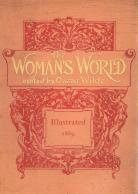Objectification and Feminism in the Victorian Era
Created by Samantha Loree on Tue, 12/07/2021 - 23:08
Oscar Wilde speaks to themes of objectification and the obsession with preserving youth. Although applicable to women who were and are still held to the high standards of preserving themselves for marriage and aestheticism, Wilde does not write the novel for women. The hypocrisy and genius of Wilde's telling of objectification further oppresses female characters in Victorian society, while also acknowledging it. This timeline reflects the works and accomplishments of Oscar Wilde and his stance on proto-feminism in the Victorian Era.
Timeline
Chronological table
| Date | Event | Created by | Associated Places | |
|---|---|---|---|---|
| Nov 1887 |
First Issue of 'The Woman's World'In his new editorial position, Wilde's name was published in large print and the authors were given credit in print for their works. The first issue pushed fashion to the back and lengthened the issue from 36 to 48 pages, its focuses included education, literature, and a new direction for fashion. In his piece 'Literary and Other Notes' he regards the debated crossdessing and assimilation of sexual neutrality by stating the ‘dress of the two sexes will be assimilated, as similarity of costume always follows similarity of pursuits’ (WW, I, 40). |
Samantha Loree | ||
| Apr 1889 |
Wilde Leaves 'The Woman's World'Fighting to maintain editorial control in the progression of his two-year tenure, Oscar Wilde announced his departure from the magazine. After he left, 'The Woman's World' reverted back to fashion ads and coverage, which disappointed many and the magazine met its end shortly after. At his time with the magazine, Wilde encouraged and promoted female voices in literature and the political and socio climate of womanhood. The magazine was extended in length by Wilde's determination to add more literature and the fashion aspect was pushed to the back, signifying its unimportance to pressing matters from authors in the beginning. Although Wilde had had sincerity for the paper and it's goal to hear women and expand its audience to men as well, he stepped away due to frustrastions involving his lack of control and the state of the paper from the beginning. Expressing his complaints to a friend, ‘The work of reconstruction was very difficult as the Lady’s World was a most vulgar trivial production, and the doctrine of heredity holds good in literature as in life’ (The Complete Letters of Oscar Wilde, 332). He had been proven adventurous and allied with the women's movement, and unfortunately holds true that the paper reverted back to its old ways and eventually discontinued as a result of his departure. https://victorianweb.org/authors/wilde/fitzsimons.html
|
Samantha Loree | ||
| 14 Apr 1893 |
'A Woman of No Importance' First PrintIn Wilde's play, he explores the double standards and demands of women in the Victorian Era. Following Mrs. Arbuthnot, an unwed mother who struggles to upkeep her status as a single Victorian mother and the attitude of keeping women moral by punishing them for standards men do not have to face. It is an empowering story of female independence in a society actively working to ensure women depend on men. Wilde's play is female-centric and aware of first wave feminism in the Victorian era. The play was left with mixed reviews durig its run in the Hamarket Theatre in London. It has been deemed the least successful of Wilde's four drawing room plays. The other three being Lady Windermer's Fan, An Ideal Husband, and The Importance of Being Earnest. https://study.com/academy/lesson/a-woman-of-no-importance-analysis-theme... https://en.wikipedia.org/wiki/A_Woman_of_No_Importance
|
Samantha Loree |


